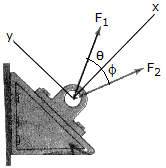A "scale" is constructed with a 4-ft-long cord and the 10-lb block D. The cord is fixed to a pin at A and passes over two small pulleys at B and C. Determine the weight of the suspended block E if the system is in equilibrium when s = 1.5 ft.
Solution: |
You can determine the weight of the suspended block 'E' BY USING COSINE LAW IN FORCE TRIANGLE.
applying the law of cos in the triangle, we will obtain the ff:
c = E
a = 10
b = 10
∝ = 132.84
where ∝ = 2θ - 180
∝ = 2(23.58) - 180
∝ = 132.84
substitute the value in cosine law where
c^2 = a^2 + b^2 - 2abcos∝
E^2 = 10^2 + 10^2 - 2(10)(10)cos132.84
E = 18.33












 and
and  so that the resultant force is directed along the positive
so that the resultant force is directed along the positive 




